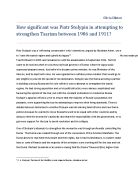Trapped between an unchangeable Tsarist regime, backed by the landowners and industrialists; and abundant peasants who did not seek gradual reformist ways forward.
· Popular indignation:
-
Peasants → more contact with the city, rising level of literacy, falling interest in Orthodox clergy: peasants impatient and resentful of private landownership.
-
Workers → level of skill, education and sense of human dignity rose. Workers became more hostile to the humiliating treatment by the managers, low level of security, low pay and privileged life of the upper classes.
· Coercive Tsarist forces:
Their ability and willingness to crush unrest were becoming doubtful.
-
Cossacks → loyalty deteriorated by financial grievances and inadequate land grants.
-
Police → small, corrupt and ill-trained
-
Army → more professionalized, officers now refused to sort out internal policing duties when they should be preparing to face potential foreign enemies.
-
The impact of the 1st WW on Russia and the way in which peasants, workers and soldiers reacted is essential to understand the success of the Bolsheviks in coming to power in October 1917.
Explaining the Bolshevik Victory.
· Effects of the 1st World War on Tsarism:
-
Military reversals → soldiers refused to crush the disturbances; no support for Nich. II anymore.
-
Economic strain → industry hit by repeated waves of strikes. Culminated in general strike and mass demonstrations.
Incompetence of the regime and no legitimacy for Nich. II. Forced to abdicate in 1917.
· Liberalism:
- Formed a provisional government in 1917.
-
Lacked coercive power → Liberal Gvt. was unable to use force to impose its will upon workers and peasants → creation of a people’s militia.
-
Policies of the liberal ministers → they could not count upon the voluntary obedience of their new subjects for long.
- The Provisional Gvt. insisted on fighting for victory, contrary to the popular will.
-
Insensitive to workers’ ideas → workers sought transformation in factory order, rise in wages and guaranteed work. Liberals upheld managerial authority and urged workers to save.
-
Insensitive to peasants’ ideas → peasants asked for a land reform. Liberals preferred to postpone crucial issues until they could be solved by legal actions.
-
April 1917: Provisional Gvt. implores socialist politicians to enter a coalition with them. Mensheviks (the moderate Marxist workers’ Party) accept for what they thought was the good choice for Russia.
- They were WRONG. Popular impatience was rising:
-
Peasants → exasperated by prevarication and deliberate delay over land reform.
-
Workers → alarmed by accelerating inflation, rising unemployment and deliberate lockouts and sabotage by managers.
-
Turning point: Moderate socialists (Mensheviks) threw a renewed offensive against Germany. Militarily → Fiasco. Russians soldiers
refused to obey their officers.
Politically → Loss of military popularity of
the moderates.
Lower classes: alternative political leader, respond to their demands.
- Soldiers: Gvt. end war
- Workers: Gvt. take their side against managers, job protection.
- Peasants: Gvt. seize private land; take “care” of them.
Bolsheviks had ability to articulate popular demands.
→ Calling for peace, bread and land. Lenin’s ideas
→ Gvt. based on soviets of workers, peasants and soldiers.
VERY POPULAR POLICIES.
Transformation from Popular Rev. to Communist Dictatorship.
Situation in October 1917: - Desperate economic & military situation.
- Authoritarian strains in Bolsh. Ideology; arrogance from Rev. victory; corruption of power.
Reasons for mass permission of dictatorship:
- Break down of relationship between workers & peasants.
(Transport chaos, falling value of roubles, etc)
- Divisions within classes.
(Difference between surplus and shortage of grain)
(Food, fuel &raw material shortage; less workforce; absenteeism, etc)
-
Russian Civil War (1918): White armies vs. Red armies.
Lower classes had to choose.
Reds won: Highly centralized ruling body
→strikes, massive peasant unrest, etc.
It did not break dictatorship. →silencing of opposition, ignoring of criticism, resorting to ruthless militaristic methods.







